Excerpts from Jim Conrad's
Naturalist Newsletter
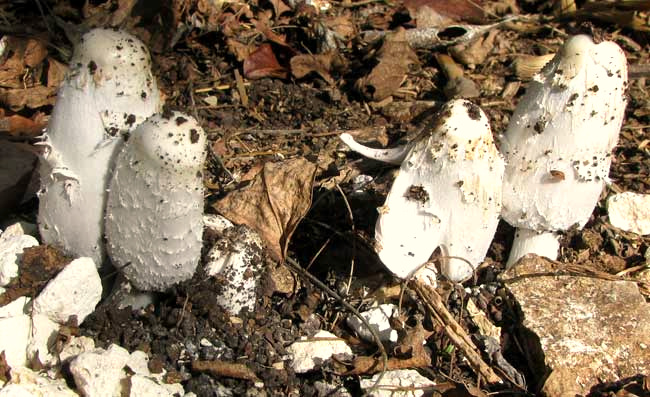
from the December 26, 2010 Newsletter issued from Hacienda Chichen Resort beside Chichén Itzá Ruins, central Yucatán, MÉXICO; limestone bedrock, elevation ~39m (~128ft), ~N20.676°, ~W88.569°
SHAGGY MANES
The Yucatán is no Mecca for mushroom pickers. For one thing the long, severe dry season is hard on moisture-loving mushrooms. For another, the soil here is too thin and low in organic matter. Still, from time to time mushrooms do pop up, and then there's yet another frustration for the mushroom picker: How do you identify them? There are no field guides here and not many mycological studies have been made in the area. So, I was tickled the other day when I stepped from the hut and saw what you can see at the top of this page.
Not only were they robust young mushroom caps soon to expand into even more photogenic parasols, but I knew what they were, more or less. From their large size (already about 3.5 inches tall, or 9 cm, despite their early stage of development), white size, conical cap shape and shaggy cap covering, these were just like emerging Shaggy Manes, COPRINUS COMATUS, I've so often seen in North America and Europe. It's a worldwide species.
By mid afternoon of that same day, already the mushrooms had grown to about six inches (15cm) and the caps had prettily expanded, as shown below:
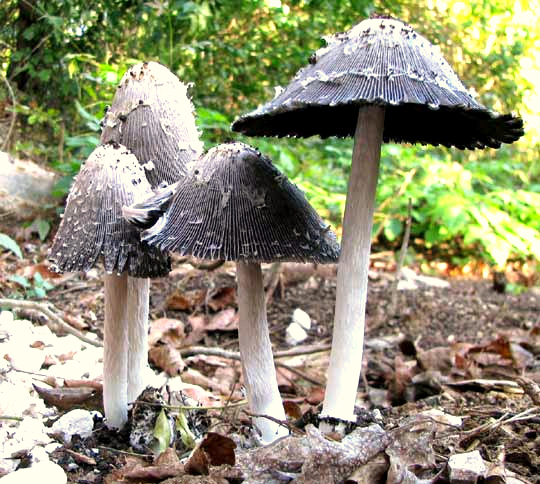
Shaggy Manes are recognized as deliciously edible mushrooms. Mycologist Clyde Christensen once wrote a popular book for mushroomers in which he introduced the "Foolproof Four" -- four very easy to identify, consistently safe and tasty mushrooms species, and the Shaggy Mane was one of those species.
However, I didn't eat these next to my hut. For one thing, I'm still a bit skittish after getting poisoned by the Green-spored Parasol Mushroom back in Kentucky in 2006. You can read all about that incident at www.backyardnature.net/n/x/green-sp.htm.
Also, the taxonomy of the genus Coprinus is in a royal mess. There are look-alike species, and who knows what lives in the Yucatán? You might find it illuminating to read how recent genetic sequencing has really screwed up the taxonomy of a once-simple and easy-to-identify group of common mushroom species at http://botit.botany.wisc.edu/toms_fungi/may2004.html.
In mushroom identification no field mark is more important than that of spore color. I already knew that Coprinus mushrooms produce black spores, but I thought I'd make a spore print to show you just for fun. You can see what came into being when I placed the cap of a newly opened one onto a sheet of paper below:
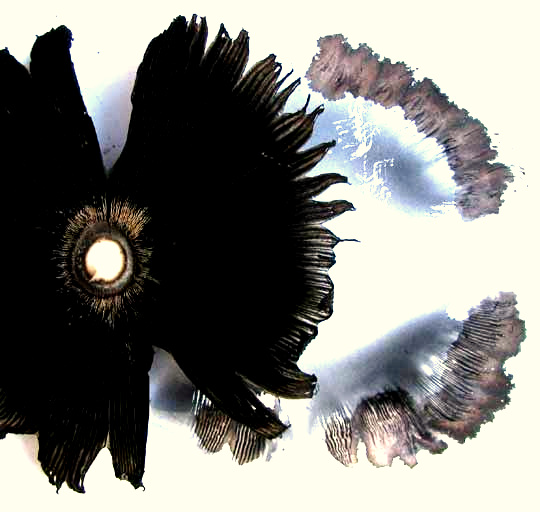
The "black sun" at the left is the cap itself flipped onto it top. The dark, diffuse "clouds" are untold numbers of spores that dropped from the cap's radiating gills during no more than 15 minutes. The wet-looking black splotches result from the cap's margins "melting." Members of the genus Coprinus often are known as inky-caps because soon after their caps open they begin melting, or "deliquescing," black spores mingling with the juice, forming " ink."
An arresting picture shows the stem attaching to the cap's inside center, surrounded by radiating gills below:
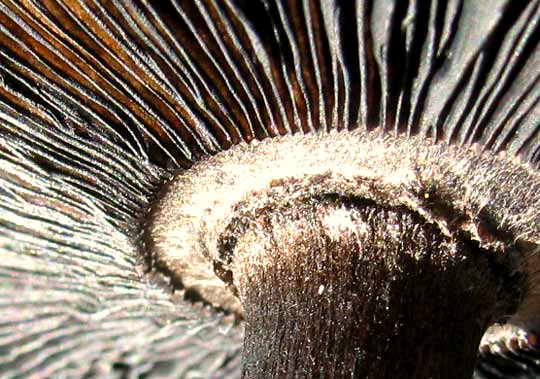
In some mushroom groups gills extend down the stem, in others there's a notch between the gills and continuing ridges on the stem, but here there's a conspicuous empty zone, like a moat around the stem.
On the Internet I read that researchers in China have found that the Shaggy Mane is one of several fungi (another being the common, well known and highly edible oyster mushroom, Pleurotus ostreatus) whose hyphae exude compounds that can stupefy and kill soil nematodes, which the fungi then digest with invasive hyphal threads. The Shaggy Maine is a carnivore!
from the July 3, 2016 Newsletter issued from Hacienda Chichen Resort beside Chichén Itzá Ruins, central Yucatán MÉXICO
SHAGGIER SHAGGY MANES
In midweek a good rain left an ephemeral pool of ankle deep water beneath the big Chinese Banyan in front of the Hacienda's main building. Two days later several five-inch-tall (13cm) clusters of very distinctive looking mushrooms pushed up through the flat, unvegetated dirt beneath the banyan, as shown below:
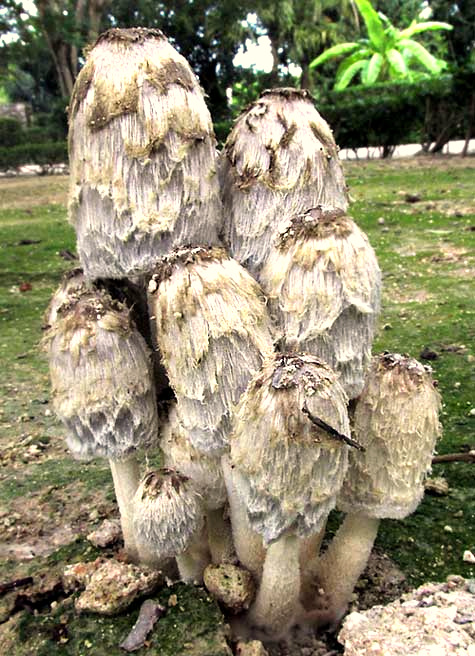
Here at the Hacienda we've seen mushrooms similar to these, as shown atop this page. The caps of the ones seen this week are much shaggier than those. Below, a close-up shows just how very shaggy this week's mushrooms were:
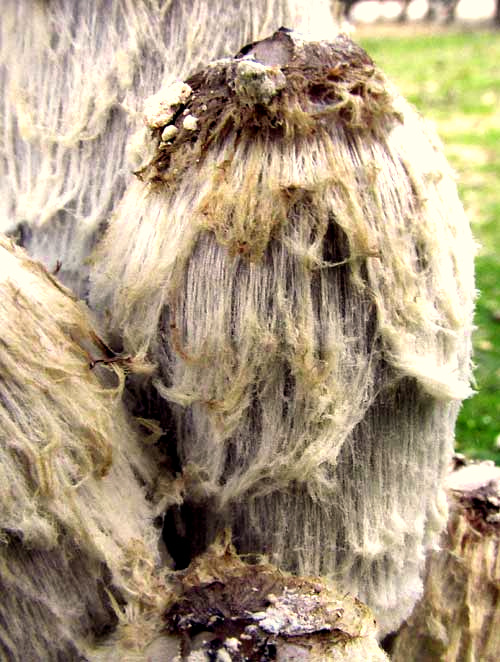
Surely this was a different species, so I took more pictures for "doing the botany." A better look at the stem bases is shown below:
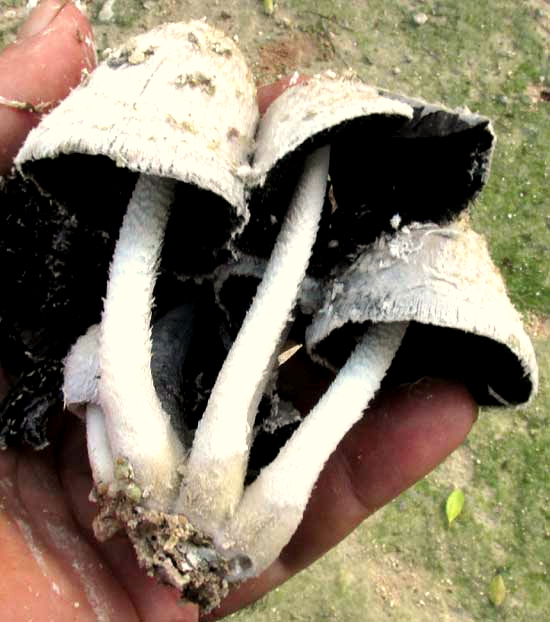
A shot showing that the cap's gills do not attach to the stem, and that the stem's top swells and spreads before the gills arise, appears below:
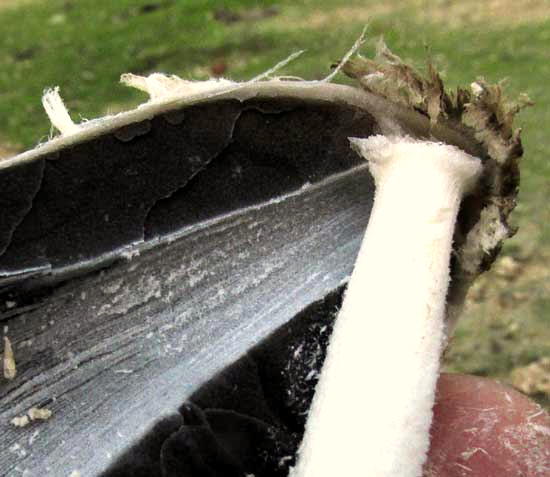
A few hours after a cap was placed on a red jar top, the cap collapsed and began liquefying, exactly as the regular Shaggy Mane does, as shown below:
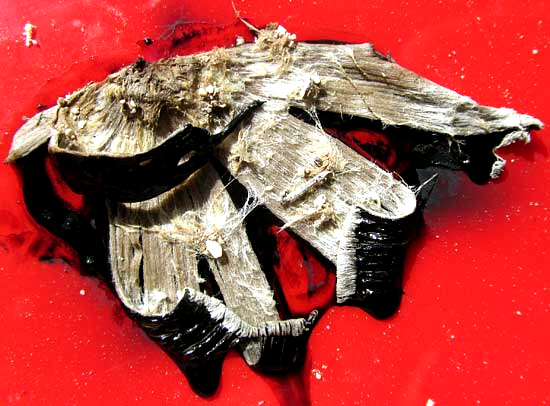
In that picture you can also see that before it collapsed it deposited a coating of black spores.
All these features coincide with those of the Shaggy Mane, except that this one is so outrageously shaggy. However, on the Internet I found other pictures of this species, Coprinus comatus, nearly as shaggy, though most are like the smoother ones photographed earlier. I read that the caps get shaggier as they mature during the day, then liquefy at day's end, but even our youngest mushrooms were as shaggy as the older ones. Apparently there can be variation in the species, which isn't surprising.
Entry from field notes dated August 15, 2022, issued from near Tequisquiapan, elevation about 1,900m (6200 ft), Querétaro state, MÉXICO
(~N20.57°, ~W99.89°)
YET ANOTHER SHAGGY LOOK
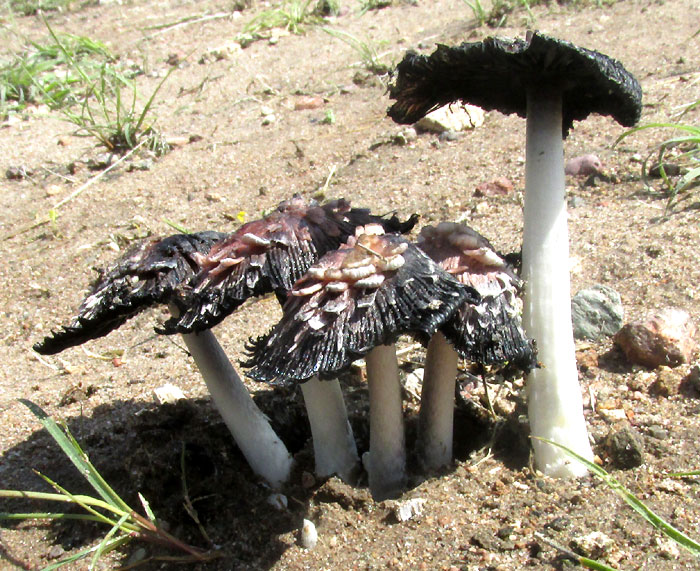
Because of the aridity, mushrooms of all kinds at this location are even rarer than in the Yucatan. The Shaggy Manes pictured above emerged about three days after one of this rainy season's very few decent rains, the rainy season hardly developing at all this year. The mushrooms inhabit a large, grossly overgrazed, eroded field where roving cattle and sheep leave their poop. Maybe the dry soil accounts for the above caps' unusual appearance. I hesitated to even identify these as true Shaggy Manes until finding images of similar caps bearing the Shaggy Mane name.
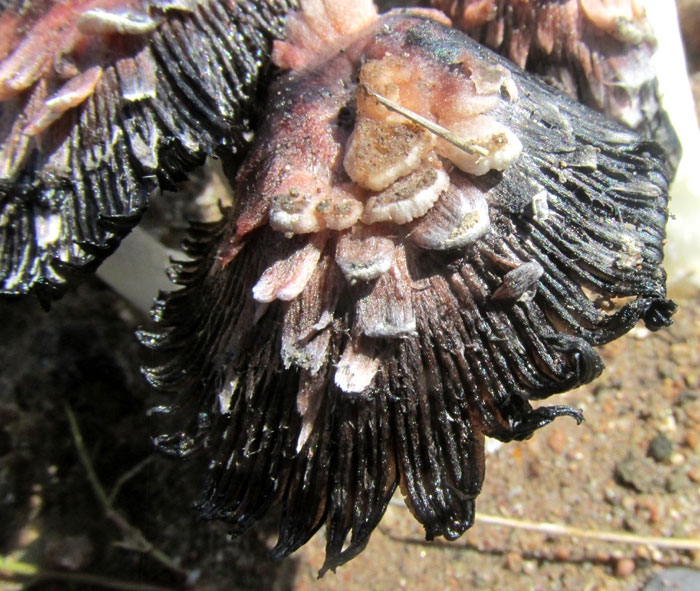
Above, a close-up focuses on the confusing feature: Where hairy shagginess should be, thick, rounded scales appear.
However, certain scales show transitions to proper shagginess, some shaggy spots maintain remains of scaliness, and at the decently shaggy bottom rims, things look ready to melt they way should. Besides, checking the GBIF occurrences map for Comprinus species occurring in this part of upland central Mexico, the regular Shaggy Mane, Coprinus comatus, was the only one to be expected here.